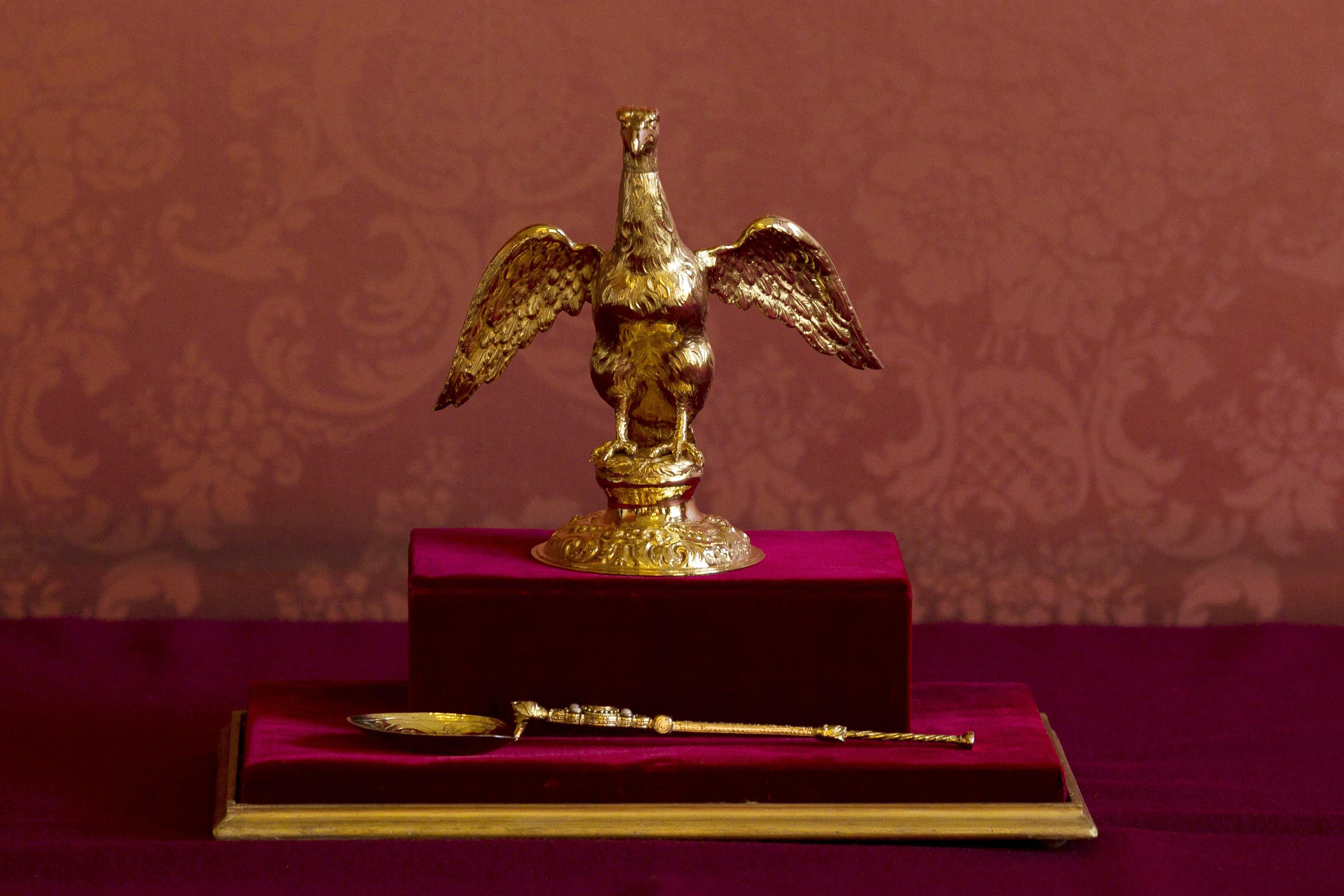The Anointing takes place before the investiture and crowning of His Majesty. The Dean of Westminster pours holy oil from the Ampulla into the Coronation Spoon, and the Archbishop of Canterbury anoints the Sovereign on the hands, chest and head. It has historically been regarded as a moment between the Sovereign and God, with a screen or canopy in place given the sanctity of the Anointing.
The mysterious anointing ceremony, known as the Act of Consecration, will take place before the investiture and crowning, and is carried out by the Archbishop. At Charles’s coronation, the Archbishop of Canterbury will be the one to anoint the King.
According to the Royal Collection Trust, the Archbishop will pour holy oil from the Ampulla (vessel) into the Coronation Spoon, a silver-gilt spoon with an oval bowl and decorated with pearls and engravings. The Ampulla is a solid gold flask in the shape of an eagle, believed to have been crafted in 1661 for the coronation of Charles II.
The Ampulla and Coronation Spoon used at the Coronation of Queen Elizabeth II in 1953
Westminster Abbey, where the coronation will be held, describes the ampulla and spoon as “the most important” objects used in the ceremony. They have both been used for hundreds of years, with the spoon first recorded in 1349. It is the only piece of royal goldsmith’s work to survive from the 12thcentury.
The Archbishop will dip two fingers into the holy oil and anoint the sovereign on the hands, breast and head. This is a tradition that dates back to the Old Testament, in which the anointing of Solomon by Zadok the Priest and Nathan the Prophet is written.
The monarch is then anointed using the Coronation Spoon with holy oil contained in the Ampulla. The Coronation Spoon is the most ancient item of Coronation regalia.
The choir traditionally sings Handel’s ‘Zadok the Priest’ during this most sacred moment of the coronation.
“Anointing was one of the medieval holy sacraments and it emphasised the spiritual status of the sovereign,” the RCT writes on its website.
The monarch was considered to have been appointed directly by God until the 17thcentury, a holy role that was confirmed by the anointing. Although monarchs are no longer considered to be divine, the anointing ceremony continues to confirm the monarch as the Supreme Governor of the Church of England.
During Queen Elizabeth’s coronation, she sat in the Coronation Chair while a gold canopy was held above her by four Knights of the Garter. Hers was the first coronation to have ever been televised, but when the moment of anointing arrived, the canopy was moved to block the Queen from public view.
According to the BBC, as he anointed her, the Archbishop said: “Be thy head anointed with holy oil: as kings, priests, and prophets were anointed. And as Solomon was anointed king by Zadok the priest and Nathan the prophet, so be you anointed, blessed and consecrated Queen over the Peoples, whom the Lord thy God hath given thee to rule and govern.”
A picture of the coronation of Queen Elizabeth II, sitting on the Coronation Chair, known as St Edward's Chair, on June 2, 1953
It is likely the same words will be uttered during Charles’ anointing, replacing the words “Queen over the Peoples” with “King over the Peoples”.
 |
The holy oil that was traditionally used for coronations past contained civet oil, from the glands of the small mammals, and ambergris from whale intestines. The formula was used at Queen Elizabeth’s ceremony and is hundreds of years old.
The king and the Queen consort will be anointed behind a specially created screen of fine embroidery, held by poles hewn from an ancient windblown Windsor oak and mounted with eagles cast in bronze and gilded in gold leaf, Buckingham Palace has announced.
The anointing screen has been blessed at a special service at the Chapel Royal at St James’s Palace, and will be used at what historically has been viewed as the most sacred moment of the coronation.
The anointing is traditionally regarded as a moment between the sovereign and God, and the screen is to be used to give sanctity to this moment. Traditionally, the moment is not photographed or televised.










No comments:
Post a Comment